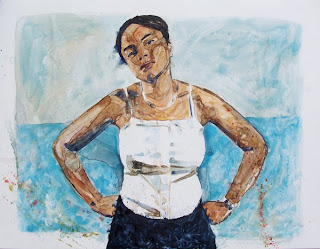 20" x 26", watercolour on Yupo, 2009
20" x 26", watercolour on Yupo, 2009Since my primary interest in painting is the figure (and I still have tons of figurative photo ref to work from and re-interpret), I thought I should try one on Yupo. Immediately, I realized that my usual glazing technique for flesh tones would have to change: I had to mix appropriate colours in various intensities so that glazing was at a minimum (as each time I ran the brush over a dry area, I risked wiping that away) while still letting the paint do what it wanted. Another chaotic element (along with colour mixing on the surface in unpredictable ways): I've discovered that the various surfaces in my studio (including the floor!) aren't perfectly level, so the paint tends to pool in the direction of the downward tilt, so now laying the paper down facing a certain direction (and sometimes rotating it, so the paint pools where I'd like it to) while the paint dries is part of the process. It's complicated, but exciting. And you can always subtract paint.
Comments